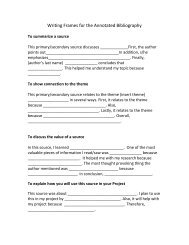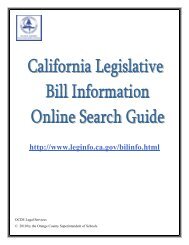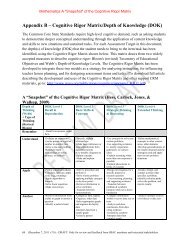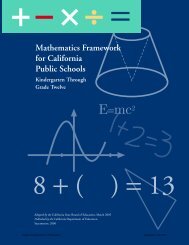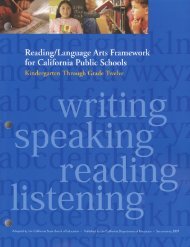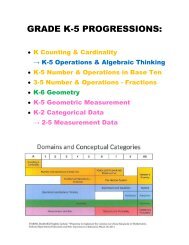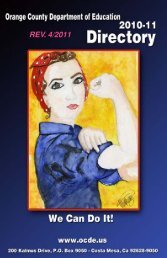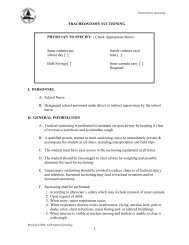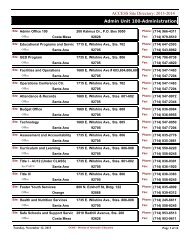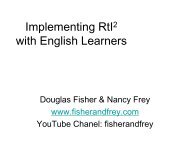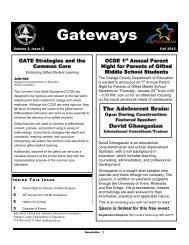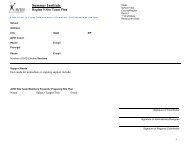The Promise and the Peril for Students with Disabilities - CalSTAT
The Promise and the Peril for Students with Disabilities - CalSTAT
The Promise and the Peril for Students with Disabilities - CalSTAT
Create successful ePaper yourself
Turn your PDF publications into a flip-book with our unique Google optimized e-Paper software.
Assessment<br />
continued from page 5<br />
multiple methods <strong>for</strong> students to access<br />
<strong>and</strong> demonstrate mastery of <strong>the</strong> content<br />
delivered in those lessons.<br />
In<strong>for</strong>mation on UDL<br />
is available from <strong>the</strong> National Center<br />
on Universal Design <strong>for</strong> Learning<br />
at www.udlcenter.org.<br />
<strong>The</strong> monumental changes in special<br />
education throughout <strong>the</strong> past decades<br />
have established a foundation that is<br />
more than capable of supporting <strong>the</strong><br />
progressive changes that lie ahead. <strong>The</strong><br />
development of <strong>the</strong> CCSS, SBAC, <strong>and</strong><br />
alternative assessments has now raised<br />
<strong>the</strong> educational bar higher than ever<br />
be<strong>for</strong>e—<strong>and</strong> that is a very good thing<br />
<strong>for</strong> all students. u<br />
References<br />
Brown, L., et al. (1983). Opportunities available<br />
when severely h<strong>and</strong>icapped students attend<br />
chronological age appropriate regular schools.”<br />
Journal of <strong>the</strong> Association <strong>for</strong> Persons <strong>with</strong> Severe<br />
H<strong>and</strong>icaps, (14)1, 8–12.<br />
Brown, L., et al. (1989). Should students <strong>with</strong><br />
severe intellectual disabilities be based in regular<br />
or in special education classrooms in home<br />
schools. Journal of <strong>the</strong> Association <strong>for</strong> <strong>the</strong> Severely<br />
H<strong>and</strong>icapped, (8)1, 16-24.<br />
Huberman, M., & Parrish, T. (2011). Lessons<br />
from Cali<strong>for</strong>nia districts. Retrieved from www.<br />
schoolsmovingup.net/cs/smu/view/rs/25889<br />
Shah, N. (2012). St<strong>and</strong>ards open <strong>the</strong> door <strong>for</strong> best<br />
practices from special education. Education<br />
Week, (31)29, 32-33.<br />
Sheinker, A., & Thurlow, M. L. (2012, April). Providing<br />
educational assessments appropriate <strong>for</strong><br />
every student: Is it possible? Presentation at <strong>the</strong><br />
International Council <strong>for</strong> Exceptional Children<br />
Conference, Denver, CO.<br />
Tucker, J. A. (2011). Beyond compliance toward<br />
Improvement.” <strong>The</strong> Special EDge, (24)2, 1–7.<br />
WestEd. (2012, May). Smarter balanced assessment<br />
consortium. Retrieved from www.wested.<br />
org/cs/we/view/pj/582<br />
<strong>The</strong> <strong>Promise</strong><br />
continued from page 1<br />
In <strong>the</strong> English language arts (ELA)<br />
st<strong>and</strong>ards document, it is noted that<br />
<strong>the</strong> st<strong>and</strong>ards allow <strong>for</strong> appropriate<br />
accommodations. It goes on to state:<br />
“For example, <strong>for</strong> students <strong>with</strong> disabilities,<br />
reading should allow <strong>for</strong> <strong>the</strong><br />
use of braille, screen-reader technology,<br />
or o<strong>the</strong>r assistive devices, while writing<br />
should include <strong>the</strong> use of a scribe,<br />
computer, or speech to text technology.<br />
In a similar vein, speaking <strong>and</strong> listening<br />
should be interpreted broadly to<br />
include sign language.” (CCSS/ELA<br />
St<strong>and</strong>ards, p. 6).<br />
All of <strong>the</strong> CCSS<br />
are available at<br />
www.corest<strong>and</strong>ards.org.<br />
<strong>The</strong>se are important statements, not<br />
only because <strong>the</strong>y show that <strong>the</strong> CCSS<br />
developers considered all students, but<br />
also because <strong>the</strong>y open up <strong>the</strong> possibility<br />
of continued discussions about access<br />
to <strong>the</strong> curriculum <strong>and</strong> about accessible<br />
assessments that measure what students<br />
really know <strong>and</strong> are able to do. Access<br />
is critical if students are going to<br />
succeed in each grade <strong>and</strong> leave school<br />
ready <strong>for</strong> college or a career.<br />
College <strong>and</strong> career readiness is<br />
appropriate <strong>for</strong> students <strong>with</strong><br />
disabilities! What does it mean to<br />
be college <strong>and</strong> career ready <strong>for</strong> students<br />
<strong>with</strong> disabilities? In large part<br />
it means <strong>the</strong> same thing as it does <strong>for</strong><br />
o<strong>the</strong>r students. David Conley at <strong>the</strong><br />
University of Oregon identified four<br />
critical dimensions of college readiness:<br />
(1) cognitive strategies, which include<br />
such higher-order thinking skills as<br />
problem <strong>for</strong>mation, interpretation, <strong>and</strong><br />
analysis; (2) content knowledge, which<br />
includes <strong>the</strong> concepts <strong>and</strong> knowledge in<br />
<strong>the</strong> disciplines; (3) skills <strong>for</strong> learning,<br />
such as time management, persistence,<br />
metacognition, goal setting, <strong>and</strong> self<br />
awareness; <strong>and</strong> (4) transition knowledge<br />
<strong>and</strong> skills, which include knowledge<br />
<strong>and</strong> awareness about applying <strong>for</strong><br />
admissions <strong>and</strong> financial aid, interacting<br />
<strong>with</strong> higher education faculty, <strong>and</strong><br />
navigating college systems.<br />
Redefining College<br />
Readiness<br />
by David Conley is at<br />
www.epiconline.org/files/pdf/<br />
RedefiningCollegeReadiness.pdf.<br />
Several individuals have identified<br />
how <strong>the</strong>se critical dimensions apply to<br />
students <strong>with</strong> disabilities, including<br />
students who have significant cognitive<br />
disabilities.<br />
Help in Transitioning to<br />
College <strong>and</strong> Career<br />
is available through <strong>The</strong> National Secondary<br />
Transition Technical Assistance<br />
Center at http://nsttac.org/content/<br />
students-w-disabilities-<strong>and</strong>-college<br />
career-readiness-101-documents.<br />
What Does “College <strong>and</strong><br />
Career Ready” Mean <strong>for</strong><br />
<strong>Students</strong> <strong>with</strong> Significant<br />
Cognitive <strong>Disabilities</strong>?<br />
is at www.naacpartners.org/<br />
publications/CareerCollege<br />
Readiness.pdf.<br />
Fulfilling <strong>the</strong> <strong>Promise</strong><br />
Focusing curriculum <strong>and</strong> teaching<br />
methods. For students <strong>with</strong> disabilities<br />
to be able to meet <strong>the</strong> st<strong>and</strong>ards<br />
described in <strong>the</strong> CCSS, <strong>the</strong>y will need<br />
a focused curriculum, <strong>and</strong> teachers<br />
will need instructional methods that<br />
address <strong>the</strong> students’ individual needs.<br />
Recent studies of districts that have<br />
been successful <strong>with</strong> all of <strong>the</strong>ir students,<br />
including those <strong>with</strong> disabilities,<br />
confirm <strong>the</strong> need <strong>for</strong> educators to focus<br />
<strong>the</strong>ir ef<strong>for</strong>ts <strong>and</strong> target instruction in<br />
order to reach agreed-upon goals.<br />
Challenging Change:<br />
How Schools <strong>and</strong> Districts Are<br />
Improving <strong>the</strong><br />
Per<strong>for</strong>mance of Special<br />
Education <strong>Students</strong><br />
from <strong>the</strong> National Center <strong>for</strong> Learning<br />
<strong>Disabilities</strong> is available at www.ncld.<br />
org/on-capitol-hill/policy-relatedpublications/challenging-change.<br />
This kind of focus is supported by<br />
all of those critical skills that special<br />
educators implement on a regular<br />
basis—<strong>for</strong> example, checking on <strong>the</strong><br />
implementation of effective strategies,<br />
using <strong>and</strong> keeping track of <strong>for</strong>mative<br />
indicators of student per<strong>for</strong>mance, <strong>and</strong><br />
ensuring that appropriate access to <strong>the</strong><br />
general education classroom <strong>and</strong> curriculum<br />
takes place.<br />
6 u <strong>The</strong> Common Core State St<strong>and</strong>ards Summer 2012 u <strong>The</strong> Special EDge




